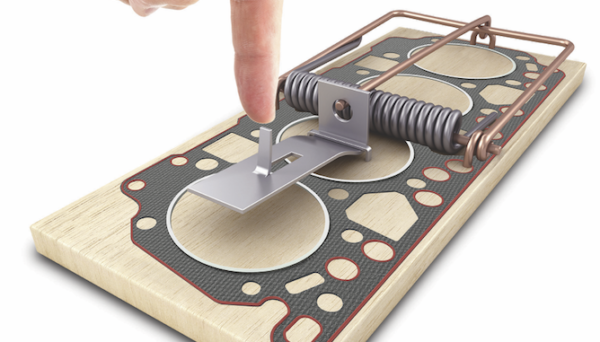Selling a replacement gasket to a customer may seem like a no-brainer. You look up the year, make, model and engine for the application, then the gasket and part number. Seems simple, right?
Yet on some applications, it’s not so simple because there may be more than one version of an engine that was produced for the same year, make and model of vehicle. The differences may be due to different emission requirements (California versus 49-state), or different cylinder heads or intake manifold. You may have to refer to the engine VIN code to determine the correct application.
Many late-model engines are equipped with Multi-Layer Steel (MLS) head gaskets. MLS head gaskets typically have 3, 4 or 5 layers of coated steel, including embossments that add “spring” so the gasket will maintain its seal over time. MLS gaskets are tough, long-lasting and capable of withstanding more abuse than ordinary head gaskets. Even so, they don’t last forever and should never be reused if a cylinder head is removed from the engine.
A really bad mistake to avoid is substituting a less expensive conventional head gasket for an application that was originally equipped with an MLS head gasket. The trade-off for saving a few bucks on a cheaper gasket will be reduced durability and longevity.
Another mistake to avoid is not recommending an upgraded aftermarket head gasket for a “problem” application that has a weak original equipment gasket design. Aftermarket gasket manufacturers are constantly studying the market to determine which applications are experiencing head gasket failures and why. They will then redesign the head gasket, adding enhancements as needed to make it better than the original. Such a gasket should reduce the risk of a repeat failure down the road.
Another mistake is replacing same with same. Most OEM MLS head gaskets require a super smooth mirror-like finish on the cylinder head and block deck surfaces to seal properly. As an engine accumulates miles, corrosion and wear can pit, erode and roughen the surface of the head and block. If an installer does not have the head and/or block resurfaced to the OEM specifications when the gasket is replaced, an OEM replacement MLS gasket may not seal. That’s why most aftermarket MLS gaskets have a thicker surface coating that can better handle surface imperfections on a high-mileage engine.
Most engines with MLS head gaskets also have torque-to-yield (TTY) head bolts. These bolts should not be reused due to the risk of breakage and loss of clamping load. Many replacement MLS head gaskets do not come with new bolts in the box, so the bolts must be sold separately. Forgetting to sell your customer new TTY bolts is a mistake you want to avoid.
MLS head gaskets are precoated, so no additional sealer is needed when the gaskets are installed. The mistake to avoid here is forgetting to remind your customer to install the gaskets dry.
Finally, don’t overlook related sales opportunities. A customer who is replacing a head gasket, oil pan gasket, valve cover gasket, timing cover gasket or intake manifold gasket will usually need additional items such as motor oil, an oil filter, coolant, maybe spark plugs, a timing belt, oil pump or other parts. Make sure they get all of the gaskets, seals and other parts they may need to complete their repairs in one stop. Recommend a gasket set rather than selling them individual gaskets for a repair job. DIY customers may also need some chemical gasket remover or a gasket scraper, and a torque wrench and angle gauge for tightening TTY head bolts.














